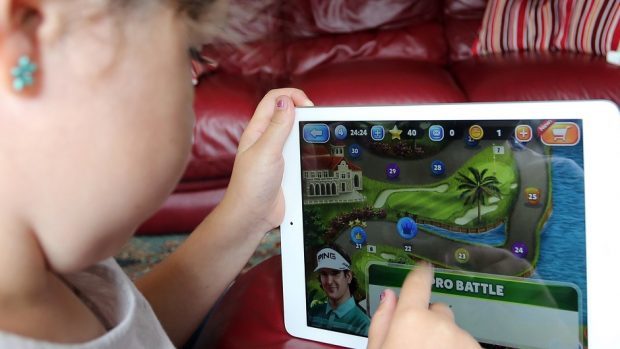“Whose phone is this?” the support worker asks.
She looks annoyed.
“We can’t let the children play with it.”
One of the mums who has left it on a table next to some paint, glue pots and glittery bits for sticking comes forward.
Thankfully, the toddlers are too busy enjoying the messy play to notice and there’s no harm done.
But it is irritating nonetheless.
Before you presume I’m being sanctimonious, I’m not.
I am a slave to my mobile as much as the next person, checking it first thing in the morning and last thing at night.
And I have taken thousands of pictures of Maya since she was born so would obviously never begrudge parents a snap – or ten – of their little one.
I am, however, careful not to have my phone out all the time – especially at a class for under-fives.
Because the children – others as much as my own – should be able to concentrate on playing without getting distracted by technology.
They should be free to play the old-fashioned way – in a screen-free space.
Clearly not everyone is as worried about this as me.
I remember one mum telling me early on, when our babies were still tiny, that she wanted her daughter to get used to her handset as quickly as possible given our reliance on computers in all areas of modern life, that I’d be fighting a losing battle to do otherwise.
While I disagree with her approach, her points are valid.
For what’s the good of limiting my mobile usage in front of my 15-month-old if she sees people staring at screens everywhere we go and, worse still, other babies her age playing with them?
Moreover, I accept Maya will be disadvantaged if current technology and the technology that hasn’t been invented yet isn’t second nature to her by the time she starts school.
But when all is said and done, I remain convinced that in these early years, it is critical to strike a balance – and more importantly to protect her from growing up too quickly.
My first mobile was a pay-as-you-go Nokia 3210 – still my favourite in terms of its reliability.
I didn’t get it until I was 17 and £10 credit seemed to last forever.
Maya will undoubtedly start badgering us for a phone or tablet much sooner than that, but I want to hold out as long as possible.
Because the dangers that will then quite literally be in the palm of her hand terrify me.
The amount of time she spends on her phone will indeed be one concern.
But much more frightening is the thought of her accessing harmful content without us knowing.
The risks have been laid bare in recent weeks through accounts of the devastating death of 14-year-old schoolgirl Molly Russell, whose father Ian has said he’s in “no doubt that Instagram helped kill” her after discovering she had viewed material linked to anxiety, depression, self-harm and suicide.
There have also been horrifying cases of radicalisation, grooming and bullying – traumas we would do anything to protect our children from in the so-called real world, but have little control over online.
I was bullied in secondary school. It was grim, but at least when I got off the bus and through my front door, it ended, I got a break.
That’s no longer true – the bully (or worse) now has free rein within the previously safe confines of a child’s bedroom as well as the playground.
By far the most petrifying part of this is that there’s only a certain amount parents can do.
Of course, Mr R and I must teach Maya about the obstacles and temptations she may come across.
We can talk to her regularly so we know about her life, take phones and tablets away at night, set age appropriate filters and so on.
But that is not enough; mums and dads can’t win this fight on our own.
The technology and social media giants, who have got away with doing far too little for far too long, must finally stand up and be counted.
In no other business would such recklessness be tolerated.
Anyone who works with children has to be vetted. Any club or group that provides somewhere for children to play or take part in sport for example has to ensure a certain level of security.
Why should it be any different online?
I’m not saying there’s a straightforward solution. I’d like to think if there was we would have done it already.
Keeping track of what children, adept at getting round the rules, are up to on the internet on multiple devices isn’t easy.
There’s also the issue of varying laws being applied across different jurisdictions.
But if these organisations can know as much about each of us as we are led to believe, then surely it has to be possible to intervene when a life might be at stake.
Saying the right thing about taking the problem seriously is what happens after a tragedy.
The words we want to hear tend to be forthcoming.
Effective action to make these platforms safer – for both children and adults – must now follow.
Sadly, it’s too late for Molly.
I hope by the time Maya’s 14, the world of social media will be a less pernicious and better regulated place.
Lindsay Razaq is a journalist and former P&J Westminster political correspondent who now combines freelance writing with being a first-time mum











